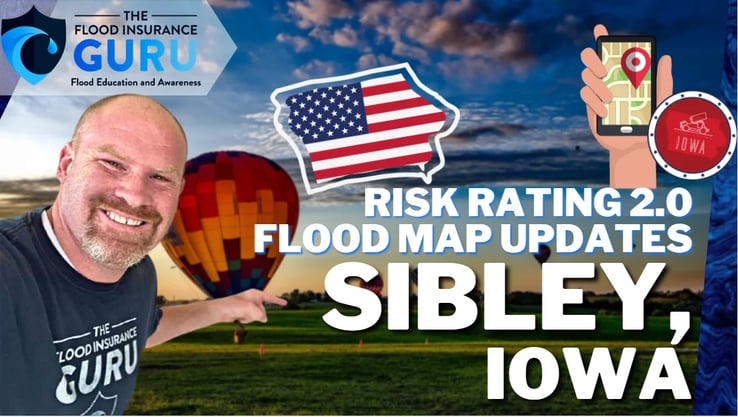
A month from the official launch of the new Risk Rating 2.0 program with FEMA and the NFIP, we equally want to focus on the upcoming changes to flood maps. The Federal Emergency Management Agency (FEMA) will be changing the flood zones for multiple states starting this month and for this one, we want to cover the upcoming update to Sibley in Iowa's Osceola County.

Flood Zones in Risk Rating 2.0
Out with the old, in with the new federal flood insurance program with Risk Rating 2.0 and this means that we're past the legacy program which looks at flood zones as a determining factor for your flood insurance rate or flood insurance premium. However, it's still crucial to understand why the Risk Rating 2.0 from the National Flood Insurance Program (NFIP) will impact the flood insurance studies and the industry itself.
You can learn more about Risk Rating 2.0 by visiting our blog covering it.
READ: NFIP Risk Rating 2.0 Update
It's important to keep in mind that Risk Rating 2.0 will only look at flood zones for regulatory purposes. This means flood insurance rate maps (FIRM) and the flood zone changes happening with it will only be used to determine whether or not a property is required to carry flood insurance or not.
Basically, the rating flood maps of old are out and the regulatory flood maps of Risk Rating 2.0 is the new standard.
Today, we discuss today the good, the bad, and the ugly changes with the flood map updates to Osceola County that will start to take effect this November 5th, 2021. We want to focus on how many properties will be impacted by this new floodplain mapping, how many properties are moving into high-risk flood zones, how many are being removed from it, and how many are going deeper into the special flood hazard areas (SFHA).
The Good
Starting with the good changes with this flood map update. We say that this is a good change because a property impacted by this will be removed from the high-risk areas or SFHA. FEMA would call this the "in to out" movement.
When it comes to Osceola County in Iowa, about 106 properties will be moved into low-risk zones. This means that if you're one of these houses moving in to out, the insured building written on your flood insurance policy will be in the moderate-to-low-risk flood areas which are Flood Zones B, Flood Zone C, and the famous Flood Zone X.

Since Risk Rating 2.0 only looks at these regulatory flood maps in order to understand the overall flood risk of a property, being in these low-risk flood areas will give you an option to not carry flood insurance to your property.
Despite this, we want to mention that low-risk doesn't mean zero risk. The risk for flooding in these areas is still very much possible although generally, the chance of flooding in these zones is very low. It's still best to carry flood insurance at all times in order to protect your property from any and all flood damage. According to FEMA, 25% of flood insurance claims come from these flood zones. Flood insurance also helps individuals start preparing by lowering their flood risk.
The Bad
Now, let's move to the bad changes coming with this new flood map update. FEMA calls this an "out to in" movement since the flood insurance rate map will take properties that are in the low-risk zones and place them into high-risk zones.
There are 2242 property owners that will experience this movement in the upcoming floodplain map. This means that if you're impacted by this bad change, the regulatory standpoint of Risk Rating 2.0 when it comes to flood zones will kick in due. Property owners that are included in the out-to-in movement will now be required to carry flood insurance regardless if they insured residential properties or commercial ones.
High-risk areas like flood zone A or 100-year floodplain generally mean that the properties in this area will have a 26% chance of flood water inundating during a 30-year mortgage.

The Ugly
Lastly, we have the ugly changes coming to Osceola County and its cities like Sibley. The ugly change is something that FEMA calls an "in to in" movement. This is because this will impact properties that are already in the SFHA and will be mapped into a higher-risk flood zone. We could also say that this is like moving your insured property from a flood zone A to a flood zone AE.

About 106 property owners are expected to experience this in-to-in movement on the flood maps. Just like the bad change or out to in, this also means that you will be required to carry a flood insurance policy for your property.
Now that we have covered the good, bad, ugly changes, and how this can impact your flood insurance purchase, let's talk about your flood insurance options in Sibley, Iowa.

The NFIP
The National Flood Insurance Program (NFIP) is purely managed by the federal government since this is FEMA's answer to flood insurance. An NFIP flood policy can get you flood coverage on both your dwelling and the contents within it.
When we say dwelling, this simply pertains to either the residential property or commercial building that you're trying to insure with NFIP and FEMA; contents will be more about the personal property and items you have inside the insured building.
There is a coverage limit when it comes to federal flood policies. Flood damage to buildings will be covered to a maximum of $250,000 for residential policies and can only go up to $500,000 maximum if it's for a commercial property. Regardless of the type of property you have written, you can expect to get a $100,000 maximum contents coverage from an NFIP policy.
There's also what's called the Increased Cost of Compliance (ICC) coverage. This is a $30,000 additional coverage for your property in order to make sure that there are flood mitigation efforts made on the property according to the federal government's standards.
Generally, this can include sandbagging your property, installing floodproofing walls, raising your lowest floor from the base flood elevation levels, and putting flood openings. The labor that goes into making these mitigation efforts happen will also be covered under the ICC.

There are also perks with your participating community in Sibley. A participating community gets access to federal flood insurance and disaster assistance, but more importantly, you also get to work with your community on raising your Community Rating System (CRS) score. The CRS measures and rewards the overall flood mitigation efforts done by the community according to FEMA's standards on floodplain management. Simply put, the higher your CRS score is, the bigger the flood insurance discount you'll get from FEMA and the NFIP.
You can start enjoying your NFIP policy after a 30-day waiting period from the flood insurance purchase.

The Private Flood
If the federal flood insurance option doesn't really work for you then you can manage this new floodplain mapping through the private flood insurance market. It's important to note that this market will solely be managed and provided by private insurance companies which generally means that the red tapes FEMA and NFIP has to go through won't be there.
The first thing you'll immediately see with the private flood market is that there are significantly shorter waiting periods for your flood policy. Once you have everything settled and paid for, a private flood insurance policy can take effect on 7 or up to 14 days maximum.

Another good thing coming out of private flood insurance is that there are no coverage limits. This means that you won't really need to stress over how to get covered for a $500,000 home since it will be fully covered by your policy. This is the same with contents coverage and you'll also get additional coverages like replacement costs, additional living expenses, and loss of use.
Fair warning, it's a known issue in the private insurance market in general that they will do moratoriums when there are risks that are too high for their comforts. This simply means that they will either put a stop or take a break from providing flood insurance policies to a certain area that has higher risks. There's also a chance that you might not get to buy flood insurance from them once they decide to non-renew your policy.
At the end of the day, the choice of where you'll be getting flood insurance depends on you. What's really important is that you know your flood risks and have enough protection from all possible outcomes of a flood event such as flood loss and flood damage.
Click the link below to access our Flood Learning Center where we try to answer your questions on flood insurance and beyond.



